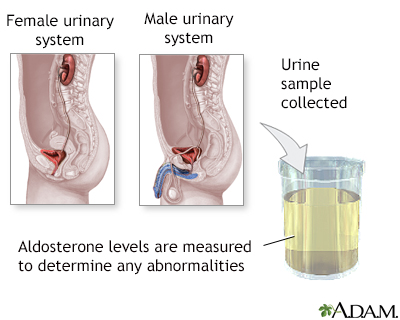Bartter syndrome
Potassium wasting; Salt-wasting nephropathy
Bartter syndrome is a group of rare conditions that affect the kidneys.
Images

I Would Like to Learn About:
Causes
There are five gene defects known to be associated with Bartter syndrome. The condition is present at birth (congenital).
The condition is caused by a defect in the kidneys' ability to reabsorb sodium. People affected by Bartter syndrome lose too much sodium through the urine. This causes a rise in the level of the hormone aldosterone, and makes the kidneys remove too much potassium from the body. This is known as potassium wasting.
The condition also results in an abnormal acid balance in the blood called hypokalemic alkalosis, which causes too much calcium in the urine.
Symptoms
This disease usually occurs in childhood. Symptoms include:
- Constipation
- Less weight gain than other children of similar age and sex (growth failure)
- Frequent urination (urinary frequency)
- Low blood pressure
- Kidney stones
- Muscle cramping and weakness
Exams and Tests
Bartter syndrome is usually suspected when a blood test finds a low level of potassium in the blood. Unlike other forms of kidney disease, this condition does not cause high blood pressure. There is a tendency toward low blood pressure. Laboratory tests may show:
- High urine potassium, calcium, and chloride levels
- High blood levels of the hormones, renin and aldosterone
- Low blood chloride level
- Metabolic alkalosis
These same signs and symptoms can also occur in people who take too many diuretics (water pills) or laxatives. Urine tests can be done to rule out other causes.
An ultrasound of the kidneys may be done.
Treatment
Bartter syndrome is treated by eating foods rich in potassium or taking potassium supplements.
Many people also need salt and magnesium supplements. Medicine may be needed that blocks the kidney's ability to get rid of potassium. High doses of nonsteroidal anti-inflammatory drugs (NSAIDs) may also be used.
Outlook (Prognosis)
Infants who have severe growth failure may grow normally with treatment. Over time, some people with the condition will develop kidney failure.
When to Contact a Medical Professional
Contact your health care provider if your child is:
- Having muscle cramps
- Not growing well
- Urinating frequently
Related Information
AlkalosisAldosterone blood test
References
Guay-Woodford LM. Hereditary nephropathies and developmental renal/urinary abnormalities. In: Goldman L, Cooney KA, eds. Goldman-Cecil Medicine. 27th ed. Philadelphia, PA: Elsevier; 2024:chap 113.
Kliegman RM, St. Geme JW, Blum NJ, et al. Inherited tubular transport abnormalities: Bartter syndrome. In: Kliegman RM, St. Geme JW, Blum NJ, et al, eds. Nelson Textbook of Pediatrics. 22nd ed. Philadelphia, PA: Elsevier; 2025:chap 571.
Mount DB. Disorders of potassium balance. In: Yu ASL, Chertow GM, Luyckx VA, Marsden PA, Skorecki K, Taal MW, eds. Brenner and Rector's The Kidney. 11th ed. Philadelphia, PA: Elsevier; 2020:chap 17.
BACK TO TOPReview Date: 12/31/2023
Reviewed By: Walead Latif, MD, Nephrologist and Clinical Associate Professor, Rutgers Medical School, Newark, NJ. Review provided by VeriMed Healthcare Network. Also reviewed by David C. Dugdale, MD, Medical Director, Brenda Conaway, Editorial Director, and the A.D.A.M. Editorial team.

Health Content Provider
06/01/2025
|
A.D.A.M., Inc. is accredited by URAC, for Health Content Provider (www.urac.org). URAC's accreditation program is an independent audit to verify that A.D.A.M. follows rigorous standards of quality and accountability. A.D.A.M. is among the first to achieve this important distinction for online health information and services. Learn more about A.D.A.M.'s editorial policy, editorial process and privacy policy. A.D.A.M. is also a founding member of Hi-Ethics. This site complied with the HONcode standard for trustworthy health information from 1995 to 2022, after which HON (Health On the Net, a not-for-profit organization that promoted transparent and reliable health information online) was discontinued. |
The information provided herein should not be used during any medical emergency or for the diagnosis or treatment of any medical condition. A licensed medical professional should be consulted for diagnosis and treatment of any and all medical conditions. Links to other sites are provided for information only -- they do not constitute endorsements of those other sites. © 1997- 2025 A.D.A.M., a business unit of Ebix, Inc. Any duplication or distribution of the information contained herein is strictly prohibited.
